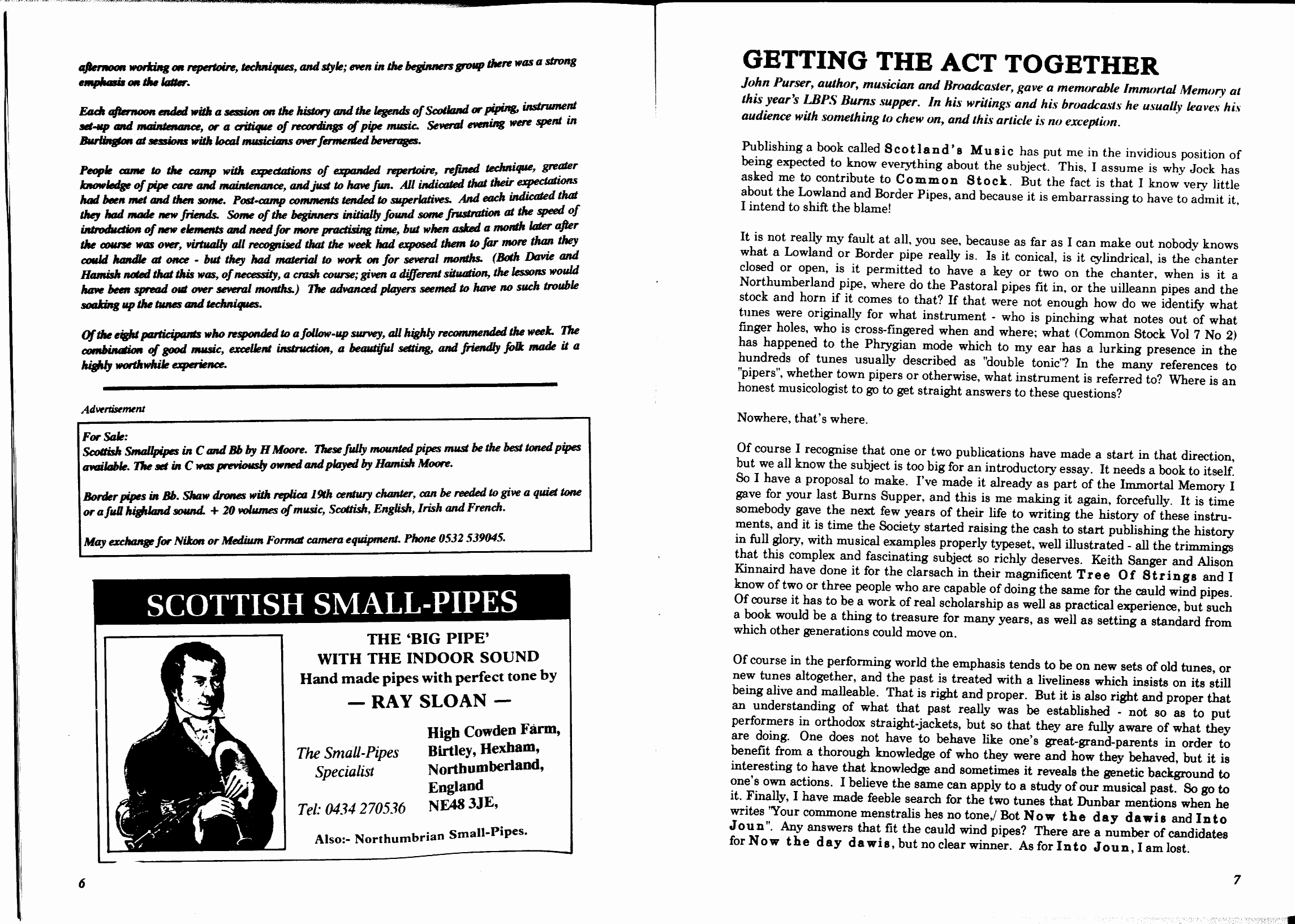Getting The Act Together

John Purser, author, musician and Broadcaster, gave a memorable Immortal Memory at this year’s LBPS Burns supper. In his writings and his broadcasts he usually leaves his audience with something to chew on, and this article is no exception.
Publishing a book called Scotland’s Music has put me in the invidious position of being expected to know everything about the subject. This, I assume is why Jock has asked me to contribute to Common Stock. But the fact is that I know very little about the Lowland and Border Pipes, and because it is embarrassing to have to admit it, intend to shift the blame!
It is not really my fault at all, you see, because as far as I can make out nobody knows what a Lowland or Border pipe really is. Is it conical, is it cylindrical, is the chanter closed or open, is it permitted to have a key or two on the chanter, when is it a Northumberland pipe, where do the Pastoral Pipes fit in, or the uilleann pipes and the stock and horn if it comes to that? If that were not enough how do we identify what tunes were originally for what instrument - who is pinching what notes out of what finger holes, who is cross-fingered when and where; what (Common Stock Vol 7 No 2) has happened to the Phrygian mode which to my ear has a lurking presence in the hundreds of tunes usually described as “double tonic’? In the many references to ‘pipers’, whether town pipers or otherwise, what instrument is referred to? Where is an honest musicologist to go to get straight answers to these questions?
Nowhere, that’s where.
Of course I recognise that one or two publications have made a start in that direction, but we all know the subject is too big for an introductory essay. It needs a book to itself. So I have a proposal to make. I’ve made it already as part of the Immortal Memory I gave for your last Burns Supper, and this is me making it again, forcefully. It is time somebody gave the next few years of their life to writing the history of these instruments, and it is time the Society started raising the cash to start publishing the history in full glory, with musical examples properly typeset, well illustrated - all the trimmings that this complex and fascinating subject so richly deserves. Keith Sanger and Alison Kinnaird have done it for the clarsach in their magnificent Tree Of Strings and I know of two or three people who are capable of doing the same for the cauld wind pipes. Of course it has to be a work of real scholarship as well as practical experience, but such a book would be a thing to treasure for many years, as well as setting a standard from which other generations could move on.
Of course in the performing world the emphasis tends to be on new sets of old tunes, or new tunes altogether, and the past is treated with a liveliness which insists on its still being alive and malleable. That is right and proper. But it is also right and proper that an understanding of what that past really was be established - not so as to put performers in orthodox straightjackets, but so that they are fully aware of what they are doing. One does not have to behave behave like one’s great-grand-parents in order to benefit from a thorough knowledge of who they were and how they behaved, but it is interesting to have that knowledge and sometimes it reveals the genetic background to one’s own actions. I believe the same can apply to a study of our musical past. So go to it. Finally, I have made feeble search for the two tunes that Dunbar mentions when he writes “Your commone menstralis hes no tone,/ Bot Now the day dawis and Into Joun”. Any answers that fit the cauld wind pipes? There are a number of candidates for Now the day dawis, but no clear winner. As for Into Joun, I am lost.
